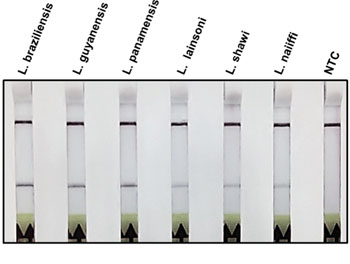Field-Applicable Molecular Test Diagnoses Tegumentary Leishmaniasis
By LabMedica International staff writers
Posted on 11 May 2016
Cutaneous and mucosal leishmaniases are widely distributed in Central and South America. Leishmania of the Viannia subgenus are the most frequent species infecting humans. L. (V.) braziliensis, L. (V.) panamensis are also responsible for metastatic mucosal leishmaniasis.Posted on 11 May 2016
Conventional or real time polymerase chain reaction (PCR) are more sensitive diagnostic tests than microscopy, but the cost and requirement for infrastructure and trained personnel makes it impractical in most endemic regions. Primary health systems need a sensitive and specific point of care (POC) diagnostic tool.

Image: The Specificity of Recombinase Polymerase Amplification -Lateral Flow (RPA-LF) immunochromatographic strip to amplify species of the Viannia subgenus. The most relevant L. Viannia species (L. braziliensis, L. guyanensis, and L. panamensis) produced stronger bands in the lateral flow strip than other less common species of this subgenus. NTC= No template control (Photo courtesy of University of Texas Medical Branch).
Scientists at the University of Texas Medical Branch (UTMB, Galveston, TX, USA) and their colleagues in South America, evaluated DNA purified from lesion biopsies of nine patients from Peru who were infected with L. braziliensis and four with L. guyanensis, as well as five non-leishmanial (PCR-negative) skin lesions. They also evaluated many different banked strains from diverse species.
The investigators developed a novel POC molecular diagnostic test for cutaneous leishmaniasis caused by Leishmania (Viannia) spp. Parasite DNA was amplified using isothermal Recombinase Polymerase Amplification (RPA) with primers and probes that targeted the kinetoplast DNA. The amplification product was detected by naked eye with a lateral flow (LF) immunochromatographic strip.
In the clinical samples they found 100% agreement between PCR and RPA-LF. The RPA-LF had an analytical sensitivity equivalent to 0.1 parasites per reaction. The test amplified the principal L. Viannia species from multiple countries: 33 L. (V.) braziliensis, 17 L. (V.) guyanensis, and nine L. (V.) panamensis. The less common L. (V.) lainsoni, L. (V.) shawi, and L. (V.) naiffi were also amplified. The specificity was confirmed by the lack of amplification of L. donovani, L. chagasi, L. mexicana, L. amazonensis, L. major, Trypanosoma cruzi and human DNA.
The authors concluded that the high analytical sensitivity and clinical validation indicated the test could improve the efficiency of diagnosis, especially in chronic lesions with submicroscopic parasite burdens. Field implementation of the RPA-LF test could contribute to management and control of cutaneous and mucosal leishmaniasis. The study was published on April 16, 2016, in the journal Public Library of Science Neglected tropical Diseases.
Related Links:
University of Texas Medical Branch














